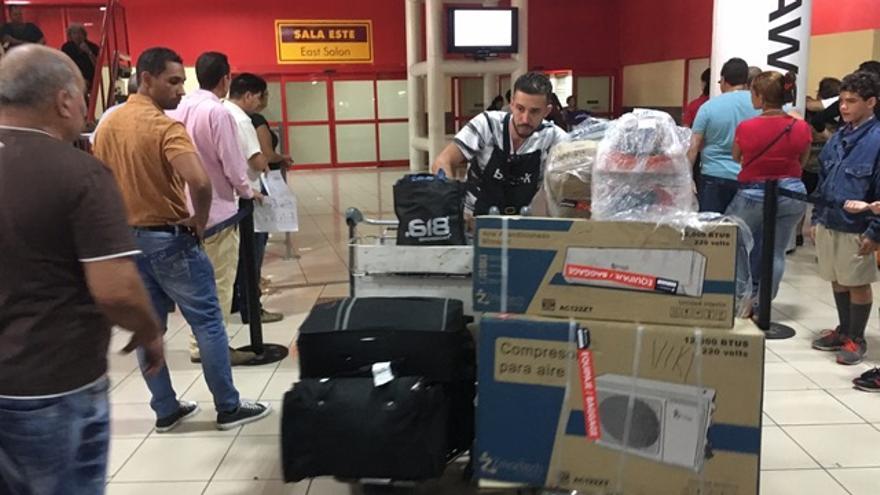
![]() 14ymedio, Zunilda Mata, Havana, 10 July 2019 — He was one of the first to obtain the ‘purchase card’ that Panama authorized for Cubans as of last October. Since then he has traveled four times to that country to bring varied goods, including three air conditioning units, popularly known as splits. “My business is cold, so people don’t sweat,” Sendry explains to 14ymedio.
14ymedio, Zunilda Mata, Havana, 10 July 2019 — He was one of the first to obtain the ‘purchase card’ that Panama authorized for Cubans as of last October. Since then he has traveled four times to that country to bring varied goods, including three air conditioning units, popularly known as splits. “My business is cold, so people don’t sweat,” Sendry explains to 14ymedio.
With temperatures exceeding 85F every day, summer in Cuba is that time of the year when a breath of refreshing air is greatly appreciated. “This business is not what it was before because the prices of the devices have dropped a lot,” says Sendry. “There is too much supply and now you make less and it takes more time to sell the merchandise.”
If two years ago a device of this type with the capacity to produce one tonne of refrigeration (TRF) cost more than 750 CUC (roughly the same in US dollars) in the informal Cuban market, now they can be less than 550, which leaves a smaller profit margin to the private importers who buy them in retail stores in other countries, pay the costs of airfares and customs duties.
In Sendry’s house, in a corner of the room, several boxes are piled up with the different parts that make up the splits, the status symbol of an emerging social class that does not want to be dripping fat drops of sweat all day. “I’ve had these here for more than two months and I have not been able to sell them although I am giving them away at 600 CUC which is the cheapest thing that can be found right now”.
In 2013, in the midst of the reforms promoted by Raúl Castro, Cubans not only saw the rules governing travel and immigration relaxed, allowing them to leave the island, but they were also authorized — after eight years of prohibitions — to import air conditioning units, electric stoves, refrigerators and microwave ovens. Both measures unleashed a real rush of personal imports.
But the “split bubble” seems to be deflating. For six years a constant trickle of these devices has landed on the island. “On my flight from Cancun, there were seven and most of them are people who bring them to sell,” says Anayansi, a woman from Matanzas who is also a naturalized citizen of Spain. She makes the trip frequently to bring clothes and shoes. “I do not deal with household appliances because they are complicated and the market here is saturated.”
The drop in enthusiasm is not only due to a greater supply, but also affected by the costs of electricity service. Although compared to other countries in the region, the island does not have the highest rates, the price of kilowatts consumed is high compared to wages.
In October 2010 electricity rates increased in the residential sector. With the current prices, the Electric Union of Cuba (UNE) begins charging 9 centavos for each kilowatt-hour (kWh) below the first 100 consumed, a rate that grows exponentially until reaching a price of 5 CUP (roughly 20¢ US) for each kWh higher at 5,000.
According to data from the last population census, published in 2012, of the 3,880,000 households in the country, about 579,000 had air conditioners. A figure that must have increased significantly in recent years, not only because of the legalization of travel, but because the State began selling these devices in their network of stores in the country, after decades without offering them.
“Before, to have air conditioning one had to be a ’vanguard worker’, or have gone to fight the war in Angola, be a sugar can cutter, and behave well, but now it is different. Those who don’t have to put up with the heat are those who travel, have hard currency, a business or family abroad” explains Richard, a 47-year-old engineer who, along with another friend, has a small AC repair team.
“The minimum you will pay for electricity, to run a modern AC all night, is about 350 CUP per month,” he tells 14ymedio . “Although modern equipment is more and more efficient, that constant expense can not be assumed by many people, so there are families who have the device installed but use it very little,” explains the technician.
For those who have a business renting rooms to tourists, it is not a choice. “We have four rooms with their respective air conditioners, all recently installed and quite efficient, but still what we have to pay monthly electricity exceeds 2,000 CUP,” says Rosendo, owner of a house on the beach of Guanabo, east of Havana.
“These devices are a costly investment, not only for the value of each and then to keep paying for electricity consumption, but also in our case we also had to put bars around the outdoor unit to protect it from thieves,” he adds. On several digital sites, second-hand and “well-maintained” AC units are offered.
Most likely, these devices come from a theft or, above all, from users who can no longer pay the electricity bill.
________________
The 14ymedio team is committed to serious journalism that reflects the reality of deep Cuba. Thank you for joining us on this long road. We invite you to continue supporting us, but this time by becoming a member of 14ymedio. Together we can continue to transform journalism in Cuba.
